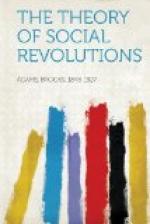The question which the Convention had to meet was how to establish the existence of a criminal mind, when nothing tangible indicated it. The old regime had tortured. To prove heresy the Church also had always used torture. The Revolution proceeded more mildly. It acted on suspicion. The process was simple. The Committee, of whom in this department Robespierre was the chief, made lists of those who were to be condemned. There came to be finally almost a complete absence of forms. No evidence was necessarily heard. The accused, if inconvenient, was not allowed to speak. If there were doubt touching the probability of conviction, pressure was put upon the court. I give one or two examples: Scellier, the senior associate judge of the tribunal, appears to have been a good lawyer and a fairly worthy man. One day in February, 1794, Scellier was at dinner with Robespierre, when Robespierre complained of the delays of the court. Scellier replied that without the observance of forms there could be no safety for the innocent. “Bah!” replied Robespierre,—“you and your forms: wait; soon the Committee will obtain a law which will suppress forms, and then we shall see.” Scellier ventured no answer. Such a law was drafted by Couthon and actually passed on 22 Prairial (June 10, 1794), and yet it altered little the methods of Fouquier-Tinville as prosecuting officer. Scellier having complained of this law of Prairial to Saint-Just, Saint-Just replied that if he were to report his words, or that he was flinching, to the Committee, Scellier would be arrested. As arrest was tantamount to sentence of death, Scellier continued his work.




